Bastar Craton covers an area of 130,000 sq. km and is bounded by the Godavari graben in the south, Mahanadi graben in the north-east, Central Indian Tectonic Zone (CITZ) forming part of the Satpura mobile belt in the north, Eastern Ghats mobile belt in the east, and Deccan Trap cover in the west. Bastar craton has also been referred to in literature as Bhandara craton or Central Indian craton. It covers southern Chhattisgarh, north-eastern Maharashtra, southwestern Odisha, and north-western Andhra Pradesh.
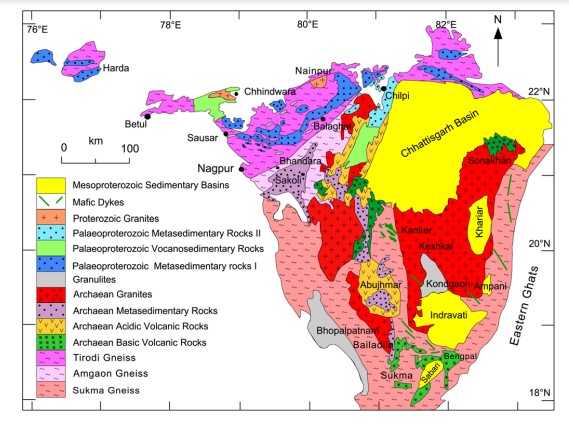
Main Components
The important litho-tectonic associations in the craton are:
- Gneissic Complex (Sukma, Amgaon), with granites of different ages (Dongargarh, Malanjkhand, Kanker, Jhiram, Sukma, etc.)
- Granulite belts (Bhopalpatnam, Kondagaon)
- Kotri-Dongargarh orogen
- Isolated fold belts of Bengpal Sakoli and Sonakhan
- Mafic dyke swarms (Bijapur, Gidam, Kondagaon, Keshkal)
- Proterozoic ‘Purana’ basins (Abujhmar, Chhattisgarh, Khariar, Indravati, Pranhita-Godavari, etc.)
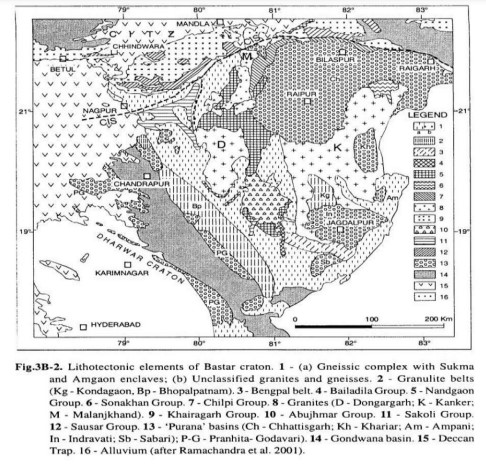
Genralised Stratigraphy
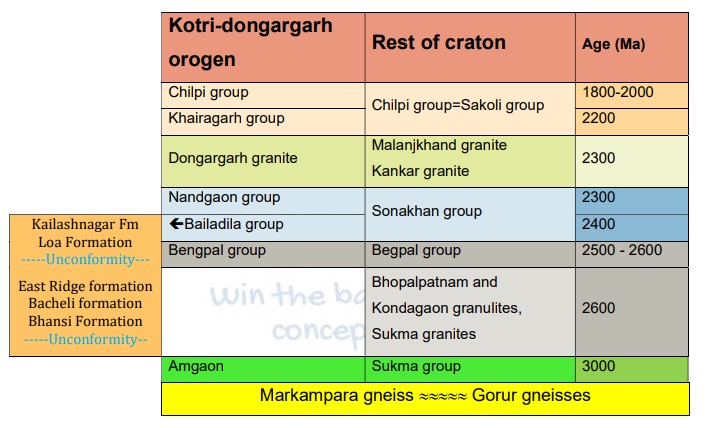
Description of Lithotectonic Units
Gneissic Complex
- TTG Suite (Tonalite-Trondjhemite-Granodioritic) Suite: Exposed in the south and west of the craton.
- Gneissic Complex (Sukma and Amagaon)
- Granitic (Dongargarh and Malanjhkhand)
- Dongargarh Granite: Closely associated with felsic volcanics.
- Malanjhkhand Granite: Responsible for the famous porphyry copper deposit of Malanjhkhand.
- Kanker Granite: Forms the basement of the Purana Basins of Bastar.
- Thirang Granite: Host to lepidolite (Li) mica and pegmatite minerals.
Granulites
- Charnockites: Any orthopyroxene-bearing quartz-feldspar rock, formed at high temperature and pressure, commonly found in granulite facies metamorphic regions.
- Leptynites: Any white-colored quartzofeldspathic rock, typically forming bands alternating with metabasic rock, irrespective of the intensity of metamorphism.
- Supra Crustal Enclaves: Occur as three prominent belts in the craton.
- Bhopalpatnam: Forming the northern part of Godavari Graben.
- Kondagaon: Northern margin of Indravati Purana Basin.
- Balaghat Bhandara: Forms part of CITZ.
Kotri-Dongargarh Orogen
A long north-to-south trending belt consisting of several cycles of sedimentation and volcanism. The K-D belt is described as an intra-cratonic orogen that does not extend beyond the boundary of Bastar Craton. The belt is not a mobile belt because mobile belts usually surround the cratons.
The K-D orogen consists of several volcano-sedimentary cycles (in ascending order):
- Basic Volcanics – Fine Clastic – BIF Association of Bailadila Group: Rich in iron ore.
- Mafic Felsic Volcanics and Pyroclastics of Nandgaon Group
- Mafic Volcanics Alternating with Clastics of Khairagarh Group
- Greywacke – Pelite Association with Minor Carbonates and Volcanics (Felsic) Belonging to Chilpi Group
The K-D orogen is overlain unconformably by Purana sedimentary basins (Chhattisgarh, Abhujmar) and is truncated by CIS (Central Indian Shear zone) that marks the boundary of CITZ or Satpura Mobile Belt.
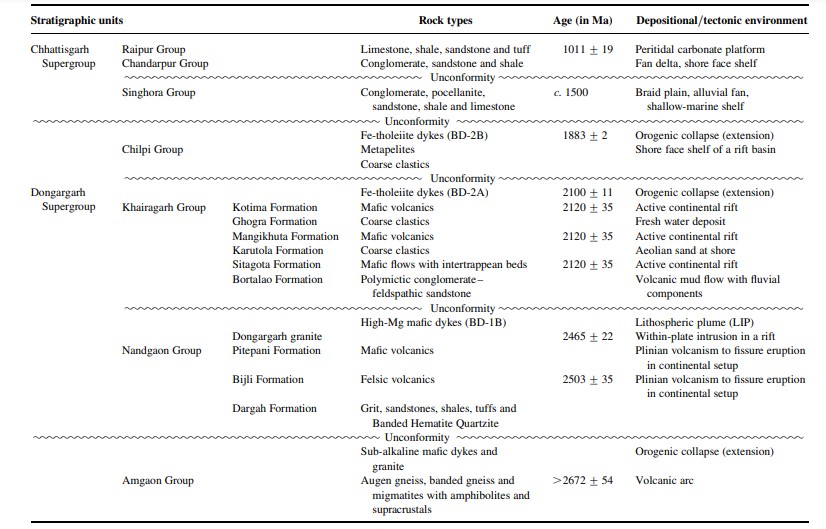
Bailadila Group
Bailadila hosts rich iron ore deposits that are extensively mined and consist of Superior type BIF.
Banded Iron Formations (BIF)
- Definition: Banded iron formations (also known as banded ironstone formations or BIFs) are distinctive units of sedimentary rock consisting of alternating layers of iron oxides and iron-poor chert. They can be up to several hundred meters in thickness and extend laterally for several hundred kilometers. Almost all of these formations are of Precambrian age and are thought to record the oxygenation of the Earth’s oceans.
- Formation: Banded iron formations are thought to have formed in seawater as the result of oxygen production by photosynthetic cyanobacteria. The oxygen combined with dissolved iron in Earth’s oceans to form insoluble iron oxides, which precipitated out, forming a thin layer on the ocean floor. Each band is similar to a varve, resulting from cyclic variations in oxygen production.
- Episodes of Formation: BIFs formed in three episodes: 3500-3000 Ma (millions of years ago), 2500-2000 Ma, and 1000-500 Ma. The BIFs from these three episodes are referred to as Algoma-, Superior-, and Rapitan-types, respectively. In each case, there were different triggers that led to their formation.
Younger Granites
- Dongargarh Granite: Covers an area of 8000 sq km, dated at 2300 Ma. It is coeval with Nandgaon volcanics and occurs as a group of three plutons (Dhanora, Chidole, and Amgaon). It shows magmatic flow and Rapakivi texture.
- Malanjhkh Khand Granite: Covers an area of 1000 sq km, dated at 2300 Ma. The Malanjhkhand Copper Deposit is the largest porphyry copper deposit in India.
- Kanker Granite: Covers an area of 100 sq km, dated at 2300 Ma, and intrudes the Sonakhan group.
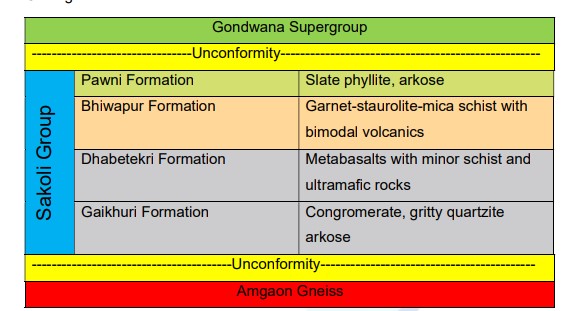
Important Points to Consider
- Manganese Deposits: Found only in the Sausar group.
- Ore Content: Mansar contains more ore than Lohangi formation.
Economic Importance
- Cu and Zn Deposits: In the southern part of Sakoli, occur strata-bound SEDEX type deposits of Cu and Zn.
- Stratiform Deposits: Stratiform deposits of zinc sulphide—mainly sphalerite—stratigraphically overlie the horizon of chalcopyrite deposits at Kolari.